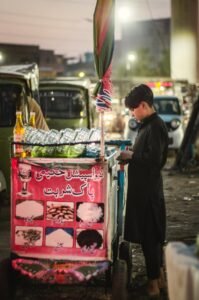The Persistent Challenge of Child Labour in Pakistan: A Call for Action
Introduction:

child labour in pakistan
Child labour is a global concern that deprives millions of children of their fundamental rights and jeopardizes their physical and mental well-being. In Pakistan, despite legislative measures and international commitments, Child Labour in Pakistan remains a persistent issue, affecting a substantial number of young lives. This article explores the root causes, consequences, and potential solutions to address the scourge of child labour in Pakistan.
Statistics
According to UNICEF, About 3.3 million Pakistani children are trapped in child labor, depriving them of their childhood, health, and education, and condemning them to a life of poverty and want. It was estimated that almost a quarter of women aged 20-49 were married before the age of 15, and 31% before eighteen years of age. Only 34% of children under five are registered at birth nationally. (PDHS) 2012-2013 Birth registration is a fundamental right of all children as legal proof of a child’s existence and identity. As an accurate record of age, it can help prevent child labor and child marriage, and protect children from being treated as adults by the justice system.
Extent of the Problem:
Pakistan, with its diverse socio-economic landscape, is home to a significant number of child labourers. According to various reports from international organizations like the International Labour Organization (ILO) and local NGOs, millions of children in Pakistan are engaged in hazardous and exploitative forms of labour. These children often work in sectors such as agriculture, manufacturing, domestic service, and the informal economy, where they are vulnerable to abuse, exploitation, and the denial of their right to education.
Root Causes:
Several interconnected factors contribute to the prevalence of child labour in Pakistan. Poverty emerges as a primary driver, forcing families to rely on the income generated by their children to meet basic needs. Insufficient access to quality education exacerbates the problem, as families may view sending children to work as a more immediate and practical solution. Additionally, cultural norms, inadequate enforcement of child labour laws, and the lack of awareness about the detrimental effects of Child Labour in Pakistan all contribute to its persistence.
Consequences of Child Labour in Pakistan:
Child Labour in Pakistan has far-reaching consequences on the physical, emotional, and cognitive development of children. Working long hours in hazardous conditions can lead to injuries, chronic health issues, and stunted growth. Moreover, child labour deprives children of the opportunity to receive an education, perpetuating the cycle of poverty and limiting their future prospects. The psychological impact of child labour is profound, as these children often face exploitation, abuse, and a loss of childhood innocence.
Legal Framework:
Pakistan has taken steps to address the issue of child labour through legislation. The Employment of Children Act, 1991, prohibits the employment of children under the age of 14 in certain occupations and regulates the conditions of work for adolescents between the ages of 14 and 18. However, the implementation and enforcement of these laws remain challenging due to a lack of resources, corruption, and inadequate monitoring mechanisms.
Government Initiatives:
The Pakistani government has initiated various programs and campaigns to combat child labour. The National Child Labour Elimination Program (NCLEP) aims to withdraw children from hazardous work and provide them with education and vocational training. Additionally, the Benazir Income Support Program (BISP) targets vulnerable families to alleviate poverty, with the hope that financial stability will reduce the need for child labour.
Role of Civil Society and NGOs:
Non-governmental organizations (NGOs) and civil society play a crucial role in addressing child labour in Pakistan. These organizations often work at the grassroots level, raising awareness, providing support to affected families, and advocating for stronger enforcement of child labour laws. Their efforts contribute significantly to creating a protective environment for children and promoting community engagement.
International Collaboration:
Given the global nature of child labour, international collaboration is essential in addressing the issue. Pakistan must work closely with international organizations, such as the ILO, and neighboring countries to share best practices, resources, and expertise. Collaborative efforts can enhance the effectiveness of interventions and create a more comprehensive approach to combating child labour.
Conclusion:
The persistence of child labour in Pakistan is a multifaceted challenge that demands a concerted effort from all stakeholders. While legislative measures and government initiatives are crucial, addressing the root causes, such as poverty and inadequate access to education, is equally important. The collective action of civil society, NGOs, the government, and the international community is essential to creating a society where every child can enjoy their right to a childhood, education, and a bright future. It is only through sustained commitment and collaboration that Pakistan can successfully eliminate the scourge of child labour and ensure a better tomorrow for its youth.
One Response
Thank you for your sharing. I am worried that I lack creative ideas. It is your article that makes me full of hope. Thank you. But, I have a question, can you help me? https://accounts.binance.com/ru/register?ref=V3MG69RO